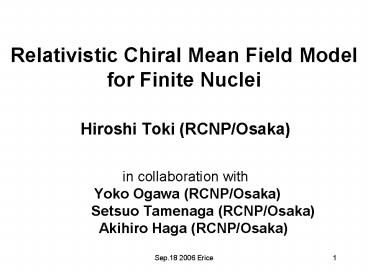Relativistic Chiral Mean Field Model for Finite Nuclei - PowerPoint PPT Presentation
1 / 39
Title:
Relativistic Chiral Mean Field Model for Finite Nuclei
Description:
Pion was introduced by Yukawa for nuclear force in 1934. ... We have succeeded to obtain renormalized chiral meson-baryon Lagrangian (vacuum effect) ... – PowerPoint PPT presentation
Number of Views:126
Avg rating:3.0/5.0
Title: Relativistic Chiral Mean Field Model for Finite Nuclei
1
Relativistic Chiral Mean Field Model for Finite
Nuclei
- Hiroshi Toki (RCNP/Osaka)
- in collaboration with
- Yoko Ogawa (RCNP/Osaka)
- Setsuo Tamenaga (RCNP/Osaka)
- Akihiro Haga (RCNP/Osaka)
2
Pions in nuclei
- Pion was introduced by Yukawa for nuclear force
in 1934. - Pions were isovector-peudoscalar bosons. (1940)
Pauli, Dancoff, Oppenheimer, Schwinger - After shell model of Meyer-Jansen, pions were
treated implicitly in nuclear physics - Now many physicists study pion for nuclei
- Relativistic mean field model with projection
- Renormalization of chiral symmetric model
3
Ab initio calculation of light nuclei
Pion 70 80
C. Pieper and R. B. Wiringa, Annu. Rev. Nucl.
Part. Sci.51(2001), nucl-th/0103005
4
Resolution Now and Then
Y. Fujita et al., EPJ A 13 (02) 411. H. Fujita
et al., Dr. Th. PRC
5
Experiments
- High resolution GT (pionic) excitations
High resolution (30keV)
H. Fujita et al (RCNP) 2003 Tamii for (p, p)
6
Chiral sigma model
Y. Ogawa et al. PTP (2004)
Pion is the Goldstone boson of chiral symmetry
- Linear Sigma Model Lagrangian
Polar coordinate
Weinberg transformation
7
Non-linear sigma model
Lagrangian
r fp j
8
Relativistic chiral Mean Field Theory
Parity mixed self-consistent mean field
Single particle state with parity mixing
Intrinsic state (parity mixed state !!)
H. Toki, S. Sugimoto, and K. Ikeda, Prog. Theor.
Phys. 108(2002)903
9
Mean Field Equation
Surface pion condensation
Surface pion field
10
Numerical results
9.2
40Ca
56Ni
9.0
N20
N28
8.8
8.6
8.4
Experiment
8.2
8.0
7.8
90
80
70
60
50
40
30
20
NZ
A (Mass number)
11
56Ni
Magic effect
Parity mixed
Pion produces spin-orbit splitting!!
12
Gamow-Teller transition in Ni56
13
Symmetry projected RMF with pion
The intrinsic state is obtained in RMF and it is
parity-mixed and charge-mixed.
14
Parity projection
Kaiser, Fritsch Weise, NPA697 (2002)
0-
0-
Finelli, Kaiser Vretener, Weise NPA770(2006)
15
Charge and parity projected RMF
16
projection -2-
17
Energy components and radius
Y. Ogawa et al., PRC73 (2006) 34301
18
Parity projection
Wave function
19
Density distribution and form factor
20
He4 and He5
Myo et al (2005)
21
Phase shifts for various partial waves
22
Higher partial waves
23
Coleman-Weinberg mechanism forspontaneous chiral
symmetry breakingin the massless chiral sigma
model
- We want to include the vacuum polarization
- for the study of nuclei.
- Nobody have succeeded to work out the
renormalization - for chiral symmetric lagrangian
- We take the Coleman-Weinberg mechanism for
- this program.
24
Chiral sigma model
sigma field before the chiral symmetry breaking
sigma field after the chiral symmetry breaking
Chiral sigma model is renormalizable but ...
25
Problems of chirally symmetric renormalization
Stable
26
Reasons for these problems
1 The number of counterterms and renormalization
conditions
T. D. Lee and M. Margulies, PRD11, 1591, 1975 T.
Matsui and B. D. Serot, Ann. of Phys. 144, 107,
1982
2 Cancellation between nucleon and boson loops
does not occur.
A. D. Jackson et al, NPA407, 495, 1983 E. M.
Nyman and M. Rho, PLB60, 134, 1976
The masses of sigma and pi mesons become
tachyonic.
27
New chirally symmetric renormalization(Coleman-We
inberg)
28
Loop contributions in f4 theory
?
29
Massless nucleon and boson loops
The differences among boson and fermion loops are
sign and coupling constants, but both of them
have the same functional form.
30
One-loop corrections as origin of SCSB
Input
Output
31
The stable effective potential
Before SCSB
32
Summary of renormalization
- We construct the massless chiral model with
nucleon and boson loops in the Coleman-Weinberg
scheme. - We obtain a stable effective potential with Dirac
sea in the chiral model for the first time. - SCSB is caused by the in-balance between nucleon
and boson loops, and both nucleon and bosons
become massive at the same time. - By introducing nucleon and boson loops to the RMF
theory, naturalness restores in the massless
chiral sigma model. - As future works, we would like to study the
properties of finite nuclei, hadronic matter at
finite temperature and at high density.
33
Conclusion
- We have developed the relativistic chiral mean
field model for finite nuclei - Spin and charge projection is essential
- Pion provides a half of spin-orbit splitting
- We have succeeded to obtain renormalized chiral
meson-baryon Lagrangian (vacuum effect)
34
Radiative corrections as origin of SSB
Coleman Weinberg redefine two renormalization
conditions before the symmetry breaking in the
massless ?4 theory in order to avoid a
logarithmical singularity.
S. R. Coleman and E. Weinberg, PRD 7, 1888
(1973)
35
One-boson loop with chiral symmetry
36
Dependence on renormalization scale
37
Renormalization and Symmetry
1 The restoration of chiral symmetry
2 All of one-loop corrections are perfectly
cancelled.
Symmetry (Chiral symmetry and symmetry between
fermion and boson)
38
Naturalness and naive dimensional analysis (NDA)
H. Georgi, Adv. Nucl. Phys. 43, 209 (1993)
If naturalness holds, a dimensionless
coefficient ?n is O(1). For example, we check
the bare potential in massless f4 theory.
As the next case, we check the vacuum fluctuation
from nucleon loop in the Walecka model.
39
Estimation of naturalness































